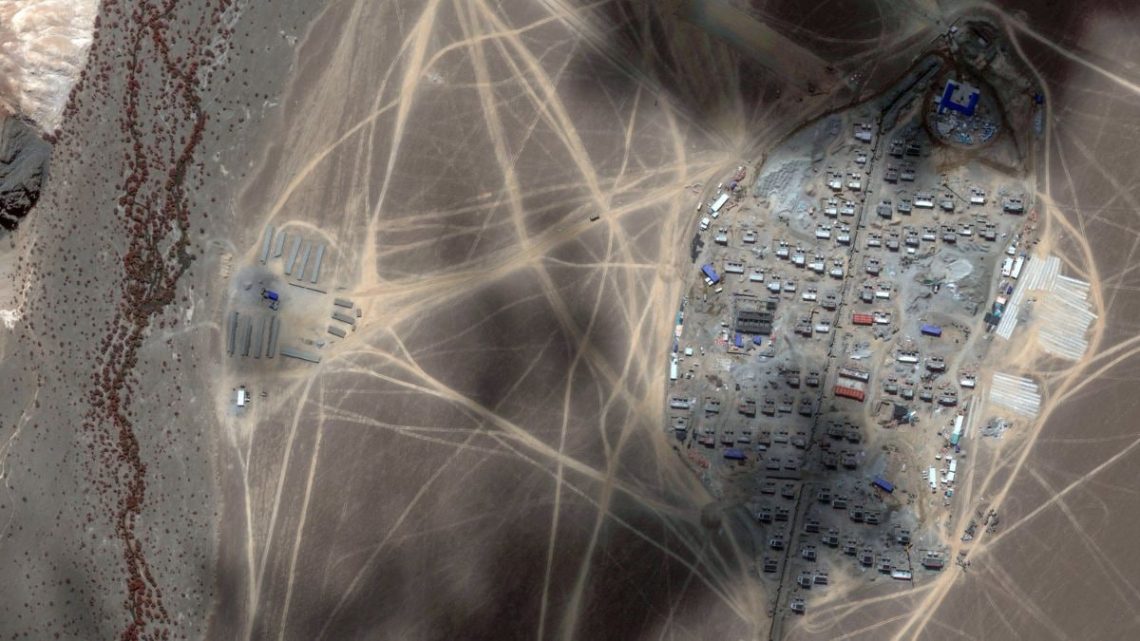Tensions between India and China continue to simmer as fresh satellite images reveal the construction of a new Chinese settlement near Pangong Tso, the strategic lake that lies at the heart of
the recent standoff between the two nations.
This development comes at a time when both countries are engaged in diplomatic negotiations to ease tensions in eastern Ladakh. The settlement adds to a series of infrastructure projects by China in the region, raising concerns about Beijing’s intentions.
What do we know so far?
Satellite images from Maxar Technologies, captured on October 9, 2024, have revealed the construction of a large Chinese settlement on the northern bank of Pangong Tso.
The settlement, consisting of over 100 permanent structures, lies approximately 38 kilometres east of the Line of Actual Control (LAC), inside Chinese territory.
“China is rapidly constructing a settlement just 8.5 km from Pangong Tso’s northern bank, with over 100 buildings already in place since work began in April 2024,” said Y Nithiyanandam, head of the geospatial research programme at the Takshashila Institution, in an India Today report.
The settlement sprawls over an area of approximately 17 hectares and is divided into two distinct sections, likely separating administrative and operational zones.
A closer examination of the structures reveals a mix of single and double-storey buildings, smaller hutments likely housing six to eight individuals each, and larger structures possibly serving administrative or storage functions.
The staggered layout of these buildings may be designed to minimise vulnerability to long-range attacks.
A key feature of the settlement is the presence of a 150-meter-long strip, which experts believe could be intended for helicopter operations. The settlement’s location, inside a valley surrounded by tall peaks, further adds to its potential as a forward base or housing for personnel.
The strategic placement, combined with its proximity to key points along the LAC, has heightened concerns in New Delhi.
How has Chinese infrastructure increased along the LAC?
This new settlement is not an isolated event. It follows a pattern of Chinese infrastructure development in the region since the April 2020 standoff, which saw violent clashes between Indian and Chinese troops.
In the past few years, China has significantly ramped up its infrastructure along the LAC, including the construction of roads, bridges, and now, settlements. One of the most notable projects is the bridge over Pangong Tso, completed in July 2024.
This nearly 400-meter-long bridge, which connects the northern and southern banks of Pangong Tso, has been a game-changer for Chinese military logistics. The bridge allows the People’s Liberation Army (PLA) to reduce its travel time between key bases from 12 hours to just 4 hours.
The bridge will significantly cut down the time required for PLA to mobilise troops and tanks. The bridge is situated in the narrowest part of the lake, allowing Chinese forces quicker access to strategic points, including areas like Rezang La, where Indian forces had gained an upper hand during the 2020 clashes.
The construction of the new settlement just 15 kilometres east of this bridge is viewed as another move by Beijing to consolidate its hold on the region.
Experts suggest that the settlement may serve dual purposes: providing accommodation for construction workers and soldiers, and storing logistics such as ammunition, food, and other supplies. “Each structure can accommodate 6-8 soldiers or up to 10 tonnes of logistics,” military experts revealed, according to NDTV.
How has India responded to China’s developments?
The strategic implications of these developments are not lost on India. The area around Pangong Tso has been a flashpoint for tensions since the beginning of the standoff in 2020.
The northern banks, known as the Finger Areas, have witnessed several skirmishes between Indian and Chinese troops, making any new construction in the vicinity a cause for concern.
The settlement’s construction started in April 2024, and by October, over 100 structures had been built, suggesting a rapid pace of development.
India has not been idle in response to these developments. Over the past few years, New Delhi has significantly ramped up its own border infrastructure along the LAC.
The Border Roads Organisation (BRO) has completed 125 infrastructure projects in 2023-24 alone. Additionally, the construction of the Shinkun La tunnel, expected to be the world’s highest at 15,800 feet, is set to provide all-weather connectivity to Ladakh, further enhancing India’s strategic preparedness.
Last week, Defence Minister Rajnath Singh inaugurated 75 BRO projects, including 22 roads and 51 bridges, primarily in regions bordering the LAC.
India’s infrastructure efforts have been matched with diplomatic engagements, but the construction of new Chinese settlements near the LAC raises serious questions about the long-term viability of the current dialogue.
What has New Delhi planned for the region?
While China continues to build infrastructure, India has also taken steps to bolster its presence along the LAC, particularly through the Vibrant Villages Programme.
Launched in 2022, this initiative aims to develop border villages across the northern frontier, with a budget of ?4,800 crore allocated until 2026. The programme targets 2,967 villages and seeks to improve connectivity, promote local livelihoods, and preserve cultural heritage.
Also Watch:
The broader strategic aim of this programme is to ensure that Indian villages along the LAC remain populated, preventing any potential territorial encroachment by Chinese forces. By improving living conditions in these remote areas, India hopes to maintain a strong civilian presence along its border, complementing its military efforts.
What next?
While diplomatic efforts to resolve the standoff continue, the rapid pace of Chinese infrastructure development raises concerns about the long-term stability of the region.
As both nations continue to strengthen their positions, the likelihood of future confrontations cannot be ruled out.
The Indian government has yet to officially comment on the new settlement, but military experts and strategic analysts are closely monitoring the situation.
Also Watch:
With inputs from agencies
Link to article –
After bridge, a new Chinese settlement near Pangong lake: What we know so far

